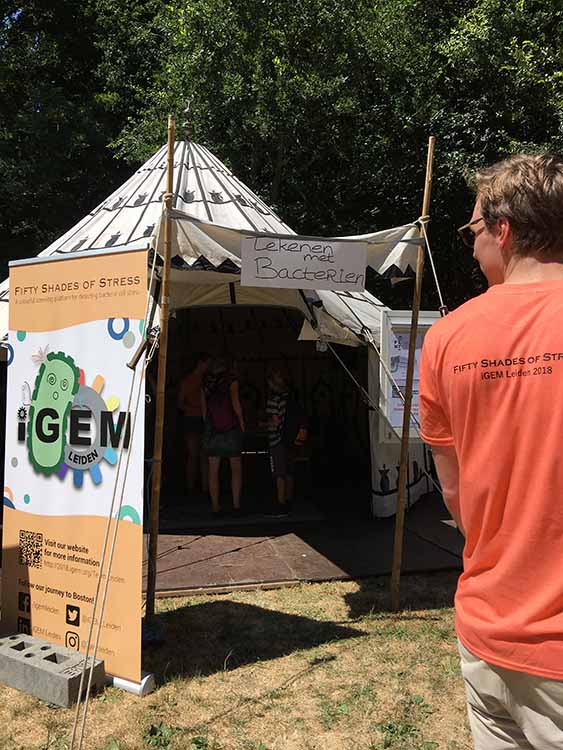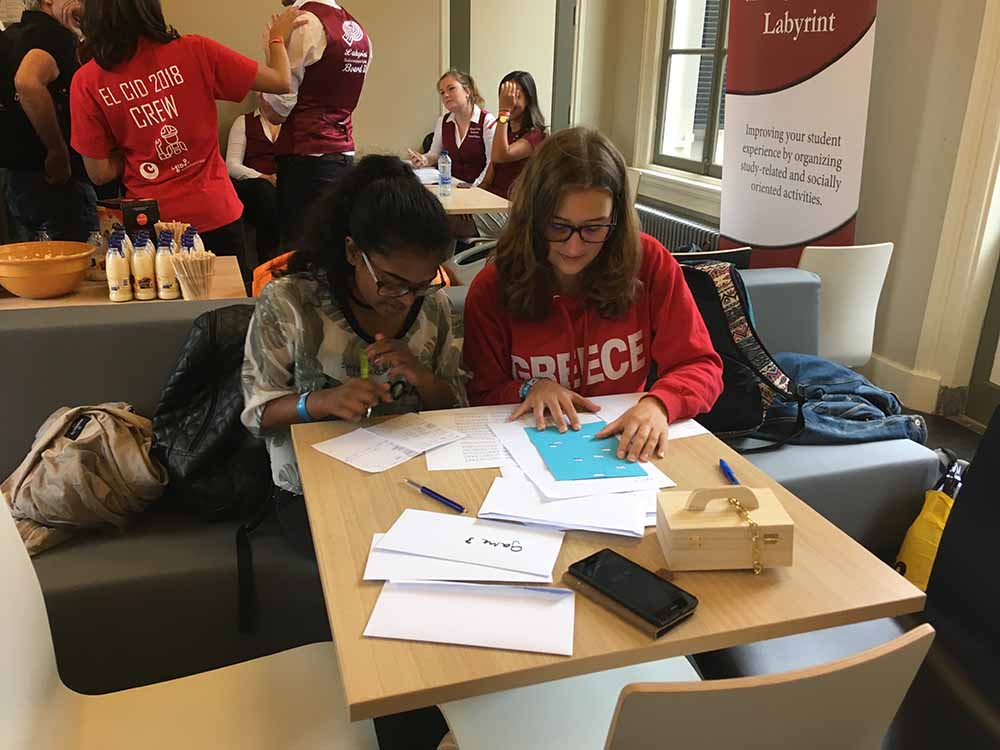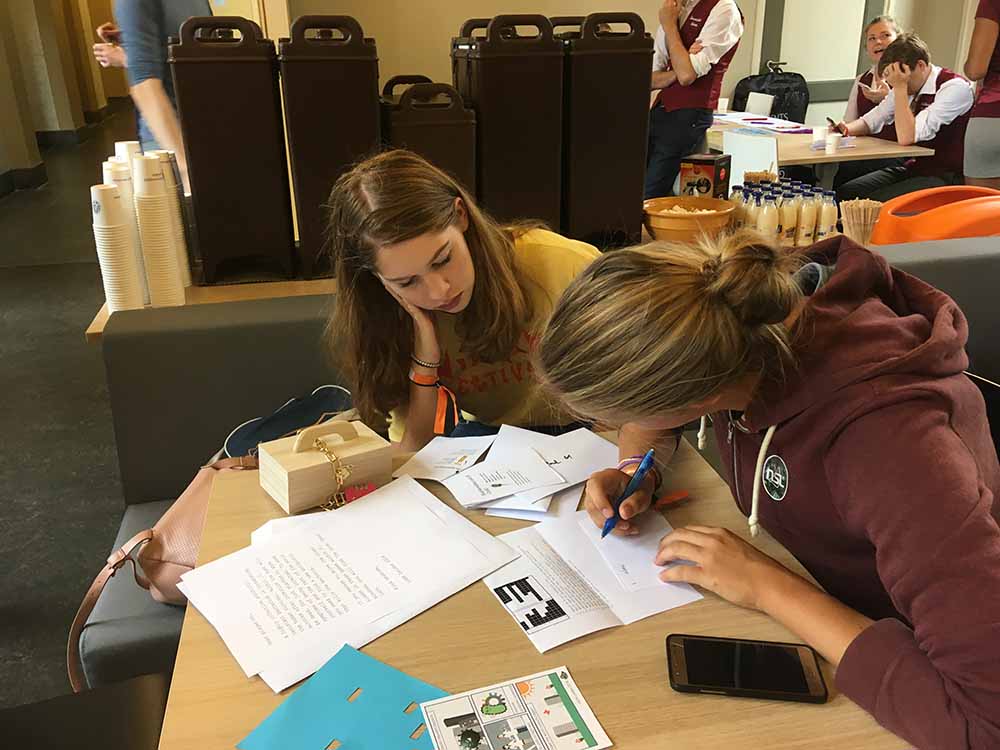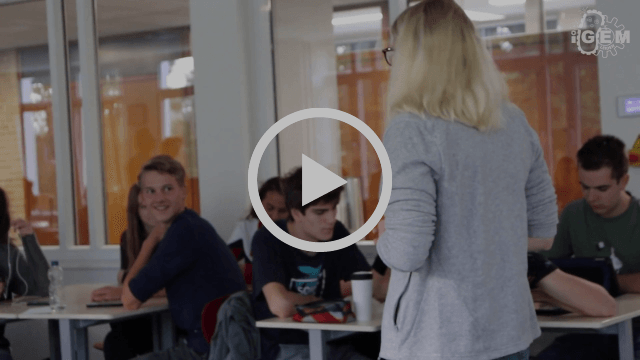Education & Public Engagement
During our Read further into our exploration of the issue of antibiotic resistance on our Integrated Human Practices pageexploration of antibiotic resistance, we found two main issues. On the one hand, we need new antibiotics to treat infections of bacteria resistant to all antibiotics. On the other hand, we also need to slow the development of further resistance against antibiotics. This second issue is also of great importance, since without solving it, resistance will quickly arise against any new antibiotics in use. Therefore, we decided early on that education and public engagement would also be an important part of our iGEM project. Our education and public engagement has resulted in the formation of an open source workshop that can be used by anyone to inform and engage participants towards antibiotic resistance and synthetic biology. The first two chapters of this page will showcase how we developed our education and public engagement and how we created our workshop. The final two chapters show how our workshop can be used and provide everything you need to use the workshop yourself. Finally, you can read about each of the events we visited on our Events page.
Starting our outreach
Our first opportunity at educating the public came with the Science Day of the Hannover Messe Challenge. Here, we gave a workshop to final year high school students, which taught them about the good and bad of bacteria. We let students perform Read further into our safety considerations for these experiments on our Safety page three experiments. First, students were asked to take swabs from objects they use daily - such as their phone or wallet - and culture these on agar plates. In the coming days, anything living on these plates would form colonies, thereby visualizing how bacteria and fungi are all around us. This served as a warning on how vulnerable we are to pathogens, and how one open wound could lead to dangerous infections. Following this, we opened a discussion on antibiotics. Explaining how we are safeguarded by them, but also how this protection is weakening, partly through our own fault. Following this experiment, we showed that not all bacteria are dangerous and that they can also be of great use to us. This was visualised to the students by allowing them to draw using colourful bacteria that also live in harmony with us on our skin and tongue. Finally, students isolated DNA from strawberries using simple techniques. This allowed us to engage in discussion on the use of genetics, and a role for synthetic biology in our future, thereby also making the students think of their own future, and the possibilities of pursuing a study and career in the up and coming field of synthetic biology. This workshop ended with our three main take-home messages:
- Antibiotics are crucial for protecting us against the pathogens that always surround us
- Bacteria can also do great good
- Synthetic biology allows us to utilise the good of bacteria and other organisms, while also requiring great consideration of ethics



We were very happy with the results of this workshop. However, we did realise that informing larger amounts of people would not be feasible with this workshop format. Therefore, we tried something very different for our next event: Industry Day.
Reaching larger audiences
Industry day attracted both scientists and artists to bring them together. This lead us to try the same, by combining science and art into two large pieces of agar art. These were created using the colourful bacteria of our earlier Science
Day workshop. This was a great gateway to discuss the use of bacteria in our benefit, particularly regarding synthetic biology, with people not used to such topics. These discussions were great, although we did realise that this more
passive
presentation did not work as well to engage the public.
For our following two events, the Museum Night and the festival Werfpop, we worked on combining what we learned at the Science Day and Industry Day, in order to both actively engage the public and be able to reach larger crowds of people.
During both events, we attracted visitors using our agar art activity, during which people of all ages made fun drawings using naturally colourful bacteria. While drawing, we were able to talk to visitors about both the dangers and
possibilities of bacteria, and our need for antibiotics in keeping us safe. Due to this more accessible format, we were able to engage with a few hundred visitors at both events, while still getting them to think critically of bacteria,
antibiotics and synthetic biology. It was rewarding to see how much visitors learned and opened up, saying they felt like they understood the problem of antibiotic resistance and the issue of synthetic biology much better. This will allow
them to both better act on these issues and form a more educated opinion. To ensure people would not forget about us and what they had learned during our discussions, we let them participate in a competition using their created agar art.
After their drawings had gotten the chance to grow, they could post pictures on social media and visit our website to see who had won. This, in combination with the drawing they took home, ensured our lessons on antibiotic resistance would
not be forgotten.



We also tested these opinions at the Werfpop festival by asking participants whether they are in favor of genetic engineering. Voting was performed by putting coloured eppendorf tubes into large yes/no canisters. The final tally showed 110 votes in favor and 45 against. Additionally, we asked participants to fill in a short survey to investigate their opinions on synthetic biology further and test their knowledge on antibiotic resistance. However, we noticed participants were biased while filling in questionnaires and voting on genetic engineering, due to our presence. Particularly, a few people said they “voted in favour for us”. This lead us to discard our questionnaire results in the end.
Consulting experts on public engagement
After realising the limitations of our survey, we reevaluated and decided it would be most useful to contact experts on the subject of public awareness on antibiotic resistance instead of investigating this ourselves. For this, we talked
to
Marcel de Kort, national antimicrobial resistance coordinator at the Dutch ministry of Health, Welfare and Sport. He reaffirmed our conclusion that we not only need new antibiotics, but also need better handling of the current ones. Marcel
de Kort explained the use of antibiotics is well regulated in the Netherlands and that public awareness of antibiotic resistance is high and constantly nurtured further by awareness campaigns. This ensures antibiotics are mostly used when
really needed in the Netherlands. However, De Kort did stress that this is not the case in many other countries where public awareness is low and antibiotics are easily available.
The conversation with Marcel de Kort made us realise that an internationally oriented look on public awareness is needed. Also, our previous awareness events had shown us that a hands-on, workshop-like experience was the best way to engage
the public. However, we knew we would not be able to form international public awareness by giving workshops ourselves. Therefore, we decided to pour our current experience with raising antibiotic resistance awareness into creating a
workshop that can be used by anyone, worldwide, to spread the knowledge needed to combat antibiotic resistance together.
Escape room game
After deciding we wanted to create an internationally usable workshop, dedicated to spreading knowledge of antibiotic resistance, we quickly realised it would have to be easy to use. Therefore, we decided we wanted to create an escape
room like game. Escape rooms engage a group of players by challenging them to a series of puzzles which have to be solved within a time limit in order to claim a reward. This escape room was created based on our research into antibiotics.
You can read further about the escape room in the next chapter.
Our escape room was first tested at the El Cid introduction week for all new Leiden University students. This allowed us to test the workshop with a large group of participants who had varying amounts of prior knowledge. Participants were
very enthusiastic and the challenge helped spark interest into antibiotic resistance. However, we did find some problems to iron out and decided to shorten the game a little since most participants took over half an hour.



Expanding the workshop
With our newly improved escape room game we had the backbone of our workshop ready. Next, we worked on developing the workshop around the game. In this design, we tried to keep the number of participants as flexible as possible. We decided to start the workshop with an interactive quiz to introduce the problem of antibiotic resistance and synthetic biology. This quiz would stimulate the participants to start thinking about the problem and become active. Using the energy gained during the interactive quiz, we moved on towards the escape room game, which people had 25 minutes to solve in groups of 2-4 people. The more people present, the more groups there would be. A presentation was given following the escape room, in which we go into further detail about the problem of antibiotic resistance, what research is done and most importantly how our audience could help tackle the problem. We based this information on our conversation with representatives of the Read further about our dialogue with the Dutch government and WHO on our Integrated Human Practices page Dutch government and the WHO. By giving the presentation after an interactive quiz and escape room game we ensured the participants were already curious towards the information we would give, thereby ensuring it sticks. Also, we made sure to include interactive slides in the presentation, used to ask the audience how they would tackle problems and about what they already know. Lastly, we ended the workshop with a short agar art session to stress the fact not all bacteria are pathogens and also come with bright sides, such as their amazing colours to draw with. This agar art souvenir also ensured participants would continue thinking about our workshop, antibiotic resistance and synthetic biology after the workshop ended and maybe tell what they learned to others, when showing them their agar art.
Putting the workshop into practice
We performed our newly created workshop for two groups of 15 first year Biomedical Sciences students and a group of 30 final year high school students. This quickly showed our implementation was working as intended. Our interactive quiz
got the students energized and engaged. This ensured they were trying their hardest during the escape room gaming. We were also happy to see all but one team was able to complete the game within the 25 minute time limit. Following the
workshop, students were very attentive during our presentation and eager to learn more about antibiotic resistance and synthetic biology, leading them to ask many questions. Fortunately, the agar art session at the end of the workshop
allowed the students ample opportunity to ask these questions and discuss with us and one another.
We shot the following video to give an impression of our workshop:

“Escape the resistance” is a workshop aiming to engage and inform participants on the issue of antibiotic resistance. This chapter details all the information and documents for you to use the workshop yourself. Please feel free to do so! Also feel free to make any adaptations and improvements as you see fit.
- Workshop primary learning goals:
- Antibiotic resistance poses a big threat to humanity
- Over- and misuse of antibiotics causes antibiotic resistance, therefore:
- Only use antibiotics when prescribed by doctor
- Finish any antibiotic treatment
- Return excess antibiotics to the pharmacy, do not discard them
- Take preventative measures against infections
- Secondary learning goals:
- Synthetic biology can benefit humanity in many ways, while also requiring great consideration of ethics
- Innovation is needed in the research for new antibiotics
Part 1 - Stimulating quiz to engage participants
The workshop starts with an interactive quiz to energize participants and excite them for the subject. The quiz can be used in many ways. We suggest using Kahoot. This is a program in which participants can join via a mobile or computer web browser. This allows the answers to be tracked so that participants are scored for correct answers, answering quickly and repeatedly answering questions correctly. This, coupled with the Kahoot music creates an energetic atmosphere to engage all participants.
Part 2 - Escape the resistance game
Now that the participants have been introduced with the subject material, energized and excited for the subject, the workshop continues with an escape room game. Participants are asked to group up in teams of 2 to 5 people. Teams are
given an envelope containing everything needed for the game. The game concludes with a code that is required to open a cache with rewards. This motivates teams to be faster than their peers in solving all puzzles. We have chosen to have
enough reward caches for all teams, but only showing the extra caches after one team has finished the game. Alternatively, only one or a few caches can be created, or decreasingly rewarding contents can be used for the caches to further
increase incentive for the game.
The workshop is themed around a bacterial infection resistant to all antibiotics. When starting, the participants read they have become infected and have minutes to discover a cure. This search will require them solving four rounds of
challenges, each building on the previous one.
All materials for the workshop are provided below. Explanations on how to play the game can be found below the workshop materials. Be mindful that this explanation will contain spoilers for the escape room game. After printing our workshop
materials, you can divide them over envelopes to prepare the workshop. The main envelope should contain the game introduction (page 1 of the workshop materials) and four envelopes. Envelope one should contain the trial 1 page (page 2 of
the workshop materials) and a little booklet made from pages 3-5 of the workshop materials. Envelope two should contain the trial 2 introduction, the codon translator, the key reading frame and keys 1 and 2 (page 6-10 of the workshop
materials). Envelope three should contain the trial 3 page (page 11 of the workshop materials). Lastly, envelope four should contain cut-outs of the three disk diffusion plates (page 12 of the workshop materials).
Round one requires participants to fill in a puzzle based on information provided in a short booklet. The puzzle will result in a The correct answer is: Start ATG hint for the next trial. This trial is solved by laying a provided reading frame over a DNA sequence. To place the reading frame correctly, players should use Key 1 [spoiler] and start at ATG [spoiler]. The codons provided by the reading frame are used to find words in a provided codon translator list. These words are filled in in the third trial to finish a disk diffusion protocol. Based on this protocol, participants can learn how to use the materials for trial 4, which only contains four disk diffusions. Using the protocol, participants should realise that the disks must be ordered from best working - with the largest death zone - to the least effective. Also, one disk diffusion does not have a death zone and should therefore be ignored. Finally, after ordering the disk diffusions, the code for the reward cache can be gained by counting the amount of disks on each disk diffusion. The final code is 573 [spoiler].
Part 3 - Presenting additional information
By now, participants will be engaged in the topic of antibiotic resistance and synthetic biology. This ensures they are interested in receiving further information. We have created a short ten minute presentation which goes into further detail onto the formation of antibiotic resistance and how to prevent resistance from spreading by:
- Only using antibiotics when prescribed by a doctor
- Finishing any antibiotic treatment
- Returning excess antibiotics to the pharmacy, do not discard them
- Taking preventative measures against infections
When presenting, we recommend engaging the participants by asking them to tell what they already know, before showing the content of the presentation slides. Particularly for the slides “slowing antibiotic resistance” and “not all bacteria are harmful” slides.
Click here to download the Escape Room presentationThis presentation can be adapted to include any other information you would like the participants to learn about.
Part 4 - Closing up and discussing further
Following the presentation, a discussion is opened with participants to hear their opinions on the presented issues. This also allows people to ask any questions they still have. From our experience, this discussion is a great opportunity
to personalize the workshop to the participants.
During this discussion, we let participants draw agar art using naturally colourful bacteria. This was a fun final activity and helped participants open up. Additionally, the agar art gave participants a fun souvenir to remind them of the
workshop and the things they had learned.
